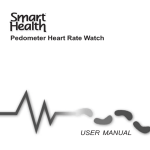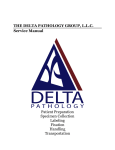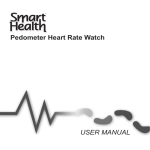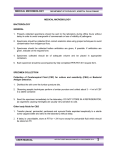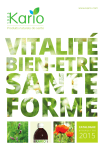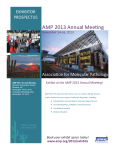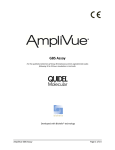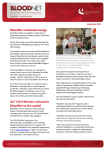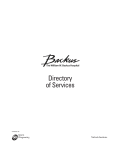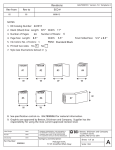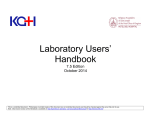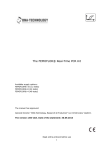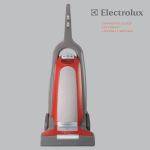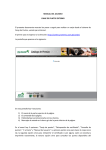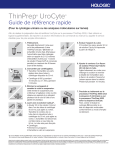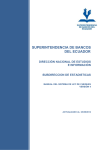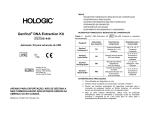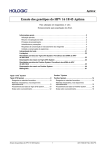Download Client Service Manual - Pathology Laboratory
Transcript
Client Services Manual TABLE OF CONTENTS GENERAL INFORMATION Contact Information & Hours of Operation Billing Policies Insurance Participation list COLLECTION MANUAL Biopsy in Formalin Biopsy - Fresh Tissue Bone Marrow Aspiration and Biopsy Fine Needle Aspiration and FNA Worksheet Urine Cytology Pap Test Human Papilloma Virus (HPV-HR, HPV 16/18, HPV expanded genotyping) Chlamydia & Gonorrhea (CT/NG) Herpes Simplex I & II (HSV 1 & II) Oral or Cutaneous Herpes Simplex Virus I & II (HSV 1 & II) Vaginitis Screen - BD Affirm (Candida, Gardnerella, Trichomonas) Bacterial Vaginosis Panel (B. fragilis, G. vaginalis, M. mulieris, M. curtisii, A. vaginae, P. bivia) Candida Panel (C. albicans, parapsilosis, tropicalis, glabrata, krusei) Urogen Panel (Ureaplasma urealyticum, Mobiluncus genitalium, Mobiluncus hominis) Cystic Fibrosis Consultations REFERENCE MATERIALS Completing the Requisition Form Pap Test Results Explained – The 2001 Bethesda System Appropriate Use of Lubricant for Pap Collection - Hologic LINK to ASCCP Consensus Guidelines at www.asccp.org/Consensus2012 FORMS AND DOCUMENTS Supply Order Form General Requisition Form Surgical Requisition Form Advanced Beneficiary Notice – Medicare MSDS: CytoLyt MSDS: Formalin MSDS: BD Affirm Ambient Transport System CLIA License CAP License Collection Manual CONTACT INFORMATION Main Laboratory Monday - Friday, 7:30am - 5:00pm 866.530.1860 616.530.0575 fax Billing Department Monday - Friday, 8:00am - 5:00pm 888.208.6228 616.532.8040 fax Email [email protected] Pathologists Houssam Attal, MD David M. Graham, MD Kim A. Mills, MD Timothy J. Pelkey, MD 866.530.1860 Sales / Client Services Donna DeWolf [email protected] 616.450.2081 Operations Mark Tanis [email protected] 866.530.1860 Aurora Diagnostics Pathology Laboratory, 2620 Horizon Drive SE, Suite 100, Grand Rapids, MI 49546 www.auroradxpathlab.com Client Manual BILLING POLICIES 8/1/13 Correct billing minimizes the number of patient complaints and phone calls and makes us all more efficient. We require the complete patient demographic, billing insurance data and ICD coding (or reason for test) in order to properly submit a claim. Assignment We participate with most carriers and accept assignment. As required by contract, co-pays, deductibles and non-covered tests, as applicable, are routinely billed to the patient after Explanation of Benefits is received. ICD Code The ICD code (billing code) must be provided with the test requisition –or- signs / symptoms / reason for visit. Medicaid Due to the increase in Medicaid HMO plans, it is imperative that you submit a copy of the patient Medicaid card Medicare An ABN (Advanced Beneficiary Notice) is required by Medicare for Pap Test collection. It must be signed by the patient prior to the testing, then submitted to us with the specimen. Commercial Insurance Billing We bill most commercial carriers directly when provided insurance card information. See the Insurance Participation List. Patient Payment Responsibility We bill first to the insurances provided with the test requisition. We balancebill patients for cash amounts owed. Please include patient address and phone number with all test requisitions. CO-PAYS We are obligated by our contracts with third-party payors to balance-bill each patient for any co-payment. DEDUCTIBLES We are obligated by our contracts with third-party payors to balance-bill each patient for any deductible. NON-COVERED TEST Some plans deny payment for certain tests even though the physician deemed the test advisable. We will bill the patient where their insurance excludes payment. Denials are sometimes successfully argued by the patient, but insurers do not hear arguments from the laboratory. CASH-PAY (no insurance) We will bill uninsured patients directly. Please include all patient demographic information requested on the test requisition. DISCOUNTS As a clinician you may occasionally offer a patient discounts. We can match your patient-bill discounts, up to 50% of our standard fee. To comply with Anti-kickback Regulations your request must be in writing and must attest to the percentage discount that you have applied. Client Manual INSURANCE PARTICIPATION LIST 8/1/13 AARP AETNA US Healthcare ASR-Physician’s Care Beech Street US Health & Life (card copy front & back) Blue Choice Blue Cross Blue Shield all but BCN primary Blue Preferred Blue Preferred Plus Champus Chandler Group ChoiceCare Network CIGNA Cofinity Community Blue DirectCare America Ethix Great Lakes Federal Mogul First Health Great West HAP (card copy front & back) Healthscope Health Plus Humana IBA Integrated Health Plan (IHP) McLaren Health Plan all but Medicaid or healthcare employee plan Medicare For Paps, patient must sign ABN Mail Handlers OneHealth PHCS PHP all but healthcare employee plan (card copy front & back) Primary Health Services PPOM/Cofinity Preferred Choices Principal Priority Health Promerica all but healthcare employee plan RealHealth Multiplan SmartHealth Plans (HPO Network) TRICARE United Healthcare UMR (United Medical Resource) Medicaid all but CareSource, Midwest Health Plan, McLaren Medicaid MultiPlan MESSA Cash Paying Patients We understand that your practice may offer patient discounts on a case-by-case basis. We can match your patient-bill discounts, up to 50% of our standard fee. To comply with Anti-kickback Regulations your request must be in writing and must specify the percentage discount that you have applied. Collection Manual BIOPSY / EXCISION - IN FORMALIN 1. Complete a requisition form - incomplete data may cause delay or rejection • Clinician name, practice / location • Patient name, address, phone, date of birth, MRN or Visit Number • Date of service, time of collection • Tissue site, position and laterality. Label multi-part specimens A, B, C etc with corresponding descriptions • History, signs and symptoms • Additional tests ie special stains, immunohistochemistry • Include a billing face sheet and/or copy of the insurance card 2. Label each biopsy jar - 2 ID's and a specimen site on each jar • Include two patient identifiers; Patient Name + (ie bar-code, MRN, Visit #, Date of Birth) • Include the specimen collection site, labeled A, B, C etc corresponding to the requisition • Apply the label to the jar 3. Submit the specimen in formalin • Small Specimen - (ie breast core, skin, cervical biopsy, ECC, GI polyp, prostate core) § Immerse each discreet specimen in a separate 40ml formalin jar. § Mark relevant margins with suture. Indicate significance of suture on the requisition • Diathermy Loop Excision § Cone - ink the squamo-columnar junction at the 12 o'clock position. Do not cut the specimen open o < 1.5cm - place in a labeled white cassette, into a 60 ml formalin jar o > 1.5cm - immerse directly into a 40 ml formalin jar § Tissue strips - ink the border nearest the cervical os and document it on the requisition. Place in a labeled lavender cassette, into a 40 ml formalin jar • Large specimen - (ie appendix, breast reduction, colon, amputation, mastectomy, placenta, uterus) § Place specimen in the smallest container (1 qt, 2 qt, 1 gal) that allows full immersion § Carefully add bulk formalin, completely immersing the specimen 4. Package for transport • Log the case on the Specimen Manifest • Tighten the lid, and then seal the jar(s) in a bio-transport bag. Keep large containers upright • Fold the requisition form and place in the outer sleeve of the bio-transport bag, name visible • Stable at room temperature • Lockbox specimens - Place an activated hand-warmer in the lockbox at <15°F. See Lockbox Instructions Limitations: Formalin fixation precludes chromosome studies, flow cytometry and frozen section. See Biopsy - Fresh Tissue Supplies: Formalin pre-fill jar (40ml, 60ml), cassette, large container (1qt, 2 at, 1 gal) + bulk formalin, ink, requisition form, bio-transport bag Formalin Caution: Eye splash - rinse for 15 minutes, then seek immediate medical attention. Ingestion - Poison, do not induce vomiting, seek immediate medical attention. Carcinogen - avoid prolonged contact and inhalation. See Formalin MSDS Guideline Links: ASCCP Guidelines for Women's Health collections Turn-around time: 93% at 24 hours; ancillary stains may add 24 hours Collection Manual BIOPSY - FRESH TISSUE 1. Call the laboratory to pre-arrange transport. These are RUSH specimens and must be scheduled. 2. Complete a requisition form - incomplete data may cause delay or rejection • Clinician name, practice / location • Patient name, address, phone, date of birth, MRN or Visit Number • Date of service, time of collection • Tissue site, position and laterality. Label multi-part specimens A, B, C etc with corresponding descriptions • History, signs and symptoms • Test(s) - specify chromosome study, flow cytometry or frozen section on the requisition • Include a billing face sheet and/or copy of the insurance card 3. Label each container - 2 ID's and a specimen site on each jar • Include two patient identifiers; Patient Name + (ie bar-code, MRN, Visit #, Date of Birth) • Include the specimen collection site, labeled A, B, C etc corresponding to the requisition • Apply the label to the jar 4. Submit the specimen as fresh tissue • Chromosome study - submit in saline soaked gauze in a sterile container • Flow cytometry - submit in saline soaked gauze in a sterile container -or- flow transport media • Frozen section - submit in saline soaked gauze in a sterile container. Provide phone number for STAT result reporting. 5. Package for transport • Log the case on the Specimen Manifest • Tighten the lid, and then seal the container(s) in a bio-transport bag. Keep large containers upright. • Fold the requisition form and place in the outer sleeve of the bio-transport bag, name visible • Refrigeration is required until transported. Limitations: Specimens submitted fresh (no formalin). Pre-schedule transport to coincide with surgery. Refrigerate until transported. Supplies: Sterile urine container, requisition form, bio-transport bag Caution: Fresh tissue should be handled observing Universal Precautions Turn-around time: Chromosome study - preliminary report 48 hours; Flow cytometry - 72 hours; Frozen section - provisional diagnosis STAT Collection Manual BONE MARROW ASPIRATION & BIOPSY 1. Complete a requisition form - incomplete data may cause delay or rejection • Clinician name, practice / location • Patient name, address, phone, date of birth, MRN or Visit Number • Date of service, time of collection • Tissue site, position and laterality. Label multi-part specimens A, B, C etc with corresponding descriptions • History, signs /symptoms and specify known cell type (ie B-cell, small cleaved cell). • Attach most recent CBC and differential reports. • Include a billing face sheet and/or copy of the insurance card 2. Label each biopsy jar - 2 ID's and a specimen site on each jar • Include two patient identifiers; Patient Name + (ie bar-code, MRN, Visit #, Date of Birth) • Include the specimen collection site, labeled A, B, C etc corresponding to the requisition • Apply the label to the jar 3. Submit the specimen as bone marrow biopsy: • Aspirate clot - submit in a 40 ml formalin jar labeled "A. Aspirate clot" • Core biopsy - submit in a 40 ml formalin jar labeled "B. Core biopsy" • Prepared slides - label each slide with patient name and site and secure in a plastic slide mailer § Peripheral smear, unstained, 1 - 2 slides § Touch prep slide, unstained, 2 slides § Bone marrow aspirate slides, unstained, 3 - 5 slides 4. Package for transport • Log the case on the Specimen Manifest • Tighten the lid, and then seal the jar(s) in a bio-transport bag. • Submit slides in a separate bio-transport bag from the formalin containers • Fold the requisition form and place in the outer sleeve of the bio-transport bag, name visible • Stable at room temperature • Lockbox specimens - Place an activated hand-warmer in the lockbox at <15°F. See Lockbox Instructions Limitations: Formalin fixation precludes chromosome studies, flow cytometry and frozen section. See Biopsy - Fresh Tissue Supplies: Formalin pre-fill jar (40ml), microscope slides, slide mailers, requisition form, bio-transport bag Formalin Caution: Eye splash - rinse for 15 minutes, then seek immediate medical attention. Ingestion - Poison, do not induce vomiting, seek immediate medical attention. Carcinogen - avoid prolonged contact and inhalation. See Formalin MSDS Turn-around time: 48 hours Collection Manual FINE NEEDLE ASPIRATION (FNA) 1. Complete a requisition form - incomplete data may cause delay or rejection • Clinician name, practice / location • Patient name, address, phone, date of birth, MRN or Visit Number • Date of service • Include a billing face sheet and/or copy of the insurance card • Provide site and clinical history on requisition or FNA Cytology Worksheet (included with FNA kit): § Organ / site, laterality or other position § Lesion features, i.e. hard, soft, size, duration, painful, attached, growth § History including prior diagnosis, clinical diagnosis, symptoms, treatment 2. Label each biopsy jar and slide - 2 ID's and a specimen site on each jar and slide • Include two patient identifiers; Patient Name + (i.e. bar-code, MRN, Visit #, Date of Birth) • Label the slides (not the mailers) in pencil. Ink will dissolve during processing 3. Evacuate prominent cysts, if present, prior to aspirating the solid mass. • If < 1 ml of cystic fluid, prepare slides per instructions in section 5 below • If > 1 ml of cystic fluid, express the evacuated cyst fluid into a labeled CytoLyt™ vial 4. Aspirate solid mass lesions • Collect multiple passes. Three passes are usually sufficient for the diagnosis of a solid lesion • Use a new syringe and needle for each pass • Insert the needle into the mass at a 90º angle • Apply appropriate vacuum to the syringe: § Moderate vacuum for non-bloody lesions § Minimal vacuum for very bloody lesions, to avoid diluting the sample with copious amounts of blood § More vacuum or a larger gauge needle for fatty or fibrous lesions. • Move the needle, within the mass, in a back and forth cutting motion. Keep the needle tip within the mass. • Change the angle of the needle to aspirate different areas of the mass. • Release the vacuum. • Withdraw the needle at a 90º angle. 5. Prepare one fixed slide and one air-dried slide per pass • Prepare 2 slides per pass by labeling one slide AD (air-dried) and one slide FX (fixed) • Carefully, remove the needle from the syringe, apply vacuum to the syringe and reattach the needle • Angle the needle-bevel flat against the FX slide and expel the entire needle contents • Invert the AD slide over the FX slide, allow the sample to spread, and gently pull the slides apart, top to bottom. • Immediately immerse the FX slide in the lavender-top alcohol slide vial • Allow the AD slide to air-dry (fanning the slide to hasten drying will enhance the smear) • Rinse the needle contents into the saline vial: § Open the saline vial and draw saline up through the needle into the syringe hub § Express the rinse back into the saline vial § Collect the needle rinses from all passes into the one saline vial • For multiple passes, repeat step 5, using a new needle and syringe for each pass. 6. Package for transport • Log the case on the Specimen Manifest • Tighten the lid(s), and then seal the vial(s) in a bio-transport bag. • Close the AD slides in the blue slide mailers and seal in the bio-transport bag • Place the requisition form and FNA Cytology Worksheet in the outer sleeve of the bio-transport bag • Stable at room temperature Collection Manual URINE CYTOLOGY 1. Complete a requisition form - incomplete data may cause delay or rejection • Clinician name, practice / location • Patient name, address, phone, date of birth, MRN or Visit Number • Method of specimen collection, for example; voided urine, catheter or wash, renal barbotage • Relevant history i.e., hematuria, fever, history of UTI, history of bladder cancer, history of renal disease, CT scan findings and suspected diagnosis • Related treatments including chemotherapy, radiation and surgery • Include a billing face sheet and/or copy of the insurance card 2. Label the CytoLyt jar - 2 ID's and a specimen site on each jar • Include two patient identifiers; Patient Name + (ie bar-code, MRN, Visit #, Date of Birth) • Include the specimen collection site, labeled A, B, C etc corresponding to the requisition • Apply the label to the jar 3. Collect 20ml to 80ml of voided urine • Do not collect the first urine of the day. The second urine is preferred • Provide the patient a moist towelette with instructions to wipe the area around the urethral opening • Instruct the patient to collect a mid-stream specimen directly into the pre-filled CytoLyt jar 4. Package for transport • Log the case on the Specimen Manifest • Tighten the lid, and then seal the jar in a bio-transport bag • Fold the requisition form and place in the outer sleeve of the bio-transport bag, name visible • Stable at room temperature Limitations: Microbiology or culture & sensitivity are separate collections and must not be submitted in CytoLyt. Refer to your clinical laboratory collection procedures Supplies: CytoLyt pre-filled jar, requisition form, bio-transport bag CytoLyt Caution: Eye splash - rinse for 15 minutes, then seek immediate medical attention. Poison - ingestion of as little as 4 oz can cause blindness, do not induce vomiting; drink 2 glasses of water and seek immediate medical attention -. See CytoLyt MSDS Guideline Links: Turn-around time: 93% at 24 hours; ancillary stains may add 24 hours Collection Manual PAP TEST - ThinPrep™ 1. Instruct the patient • Avoid douching, intercourse and lubricants 24 hours prior to exam • Schedule the exam for the non-menstrual portion of her cycle if possible 2. Complete a requisition form - incomplete data may cause delay or rejection • Clinician name, practice / location • Patient name, address, phone, date of birth, MRN or Visit Number • Date of service • Reason for Pap, specify: PAP screen low-risk, PAP screen high-risk or PAP diagnostic • History, signs and symptoms, ICD9 • Menstrual status: LMP, pregnant, postpartum, postmenopausal, hysterectomy, hormones • Medicare ABN submitted for all Medicare patients • Include a billing face sheet and/or copy of the insurance card 3. Label the vial - 2 ID's on the vial • Include two patient identifiers; Patient Name + (i.e. bar-code, MRN, Visit #, date of birth) 4. Pre-collection procedures • Lubricate the sides of the speculum with minimal lubricant (avoid the speculum head); or use water. See reference 3.4, Appropriate Use of Lubricant for Pap Collection; Hologic Nov 2012 • Collect the Pap Test prior to all other gyn collections. Visualize the cervix and describe visible lesions • Remove excess mucous, exudate and blood by gently dabbing with gauze 5. Collect a cervical sample • Rotate the spatula 360° around the ectocervix. Include "erosion" borders • Immediately swish the spatula 10 times in the vial to release the sample. Discard the spatula 6. Collect an endocervical sample • Insert the cytobrush into the endocervical canal until only a few bristles remain exposed • Rotate slowly 1/2 turn. Added rotation may cause bleeding • Immediately rinse the brush in the vial, rotating 10 times while pressing against the vial wall. • Swish the brush vigorously to further release sample. Discard the brush 7. Collect cervical/endocervical sample utilizing the broom • Insert the broom into the endocervical canal, leaving a few of the broom bristles out of the canal • Rotate the broom 360° four(4) times • Immediately rinse the broom in the vial, rotating 10 times while pressing against the vial wall. • Swish the broom vigorously to further release sample. Discard the broom 8. A vaginal sample is not routinely collected • Collect a vaginal sample using a plastic spatula, for: § Hysterectomy patients - sample the lateral vaginal wall § Visualized vaginal lesions - scrape the lesion and follow with a biopsy § Suspected endometrial carcinoma - sample the vaginal pool • Immediately swish the spatula 10 times in the vial to release the sample. Discard the spatula 9. Package for transport • Log the case on the Specimen Manifest • Tighten the vial lid, and then seal the vial in a bio-transport bag. • Fold the requisition form and place in the outer sleeve of the bio-transport bag, name visible • Stable at room temperature Limitations: The Pap Test is a screening test with irreducible false negative and false positive rates. Correlate with clinical findings. Management guidelines are recommendations and not a substitute for clinical judgment. High-yield collection is imperative. Lubricant can interfere with processing Supplies: PreservCyt™ Solution, Cytobrush + Spatula, requisition form, bio-transport bag PreservCyt™ Caution: Eye splash - rinse for 15 minutes, then seek immediate medical attention. Poison - ingestion of as little as 4 oz can cause blindness, do not induce vomiting; drink 2 glasses of water and seek immediate medical attention -. See PreservCyt MSDS Guideline Links: ASCCP Guidelines for Women's Health collections Collection Manual HPV DNA - Human Papilloma Virus 1. Complete a requisition form - incomplete data may cause delay or rejection • Clinician name, practice / location • Patient name, address, phone, date of birth, MRN or Visit Number • Date of service, time of collection • History, signs and symptoms • Include a billing face sheet and/or copy of the insurance card 2. Label a ThinPrep vial - 2 ID's on each vial • Include two patient identifiers; Patient Name + (ie bar-code, MRN, Visit #, Date of Birth) 3. Collect a ThinPrep cervical /endocervical sample. See Collection Manual, PAP TEST 4. Ordering HPV-HR (high-risk) probe options: • On a current order - check "HPV high-risk probe" and check "any result" • On a current order / REFLEX - check "HPV high-risk probe" and check the applicable Pap diagnoses • Standing Order / REFLEX is available 5. Ordering HPV 16/18 genotype - reflex if HPV-HR is Positive • On a current order check "HPV16/18" and check the Pap diagnoses to REFLEX • Standing Order / REFLEX is available 6. Ordering HPV expanded genotype - reflex if HPV-HR is Positive • On a current order check "HPV expanded genotype" and check the Pap diagnoses to REFLEX 7. Package for transport • Log the case on the Specimen Manifest • Tighten the lid, and then seal the vial in a bio-transport bag. • Fold the requisition form and place in the outer sleeve of the bio-transport bag, name visible • Stable at room temperature HPV-HR: CervistaTM HPV HR is a screen for 16, 18, 31, 35, 39, 45, 51, 52, 56, 58, 59, 66, 68. Sensitivity 92.8%. Run daily HPV 16/18: CervistaTM 16/18 is intended for use in conjunction with HPV-HR. TAT = < 5 days / run weekly HPV expanded genotype specifies 16, 18, 31, 35, 39, 45, 51, 52, 56, 58, 59, 66, 68. Sensitivity , Specificity. methodology, TAT = < 5 days / run weekly Standing Orders: You will be prompted to renew your standing order annually. You may change a standing order at any time. You may override a Standing Order on any given test by changing the requisition order Supplies: PreservCyt™ Solution, Cytobrush + Spatula, requisition form, bio-transport bag. Viability: 6 weeks without refrigeration; tests may be ordered up to 6 weeks after collection. PreservCyt™ Caution: Eye splash - rinse for 15 minutes, then seek immediate medical attention. Poison - ingestion of as little as 4 oz can cause blindness, do not induce vomiting; drink 2 glasses of water and seek immediate medical attention -. See PreservCyt MSDS Guideline Links: ASCCP Guidelines for Women's Health collections Collection Manual HPV DNA - Human Papilloma Virus 1. Complete a requisition form - incomplete data may cause delay or rejection • Clinician name, practice / location • Patient name, address, phone, date of birth, MRN or Visit Number • Date of service, time of collection • History, signs and symptoms • Include a billing face sheet and/or copy of the insurance card 2. Label a ThinPrep vial - 2 ID's on each vial • Include two patient identifiers; Patient Name + (ie bar-code, MRN, Visit #, Date of Birth) 3. Collect a ThinPrep cervical /endocervical sample. See Collection Manual, PAP TEST 4. Ordering HPV-HR (high-risk) probe options: • On a current order - check "HPV high-risk probe" and check "any result" • On a current order / REFLEX - check "HPV high-risk probe" and check the applicable Pap diagnoses • Standing Order / REFLEX is available 5. Ordering HPV 16/18 genotype - reflex if HPV-HR is Positive • On a current order check "HPV16/18" and check the Pap diagnoses to REFLEX • Standing Order / REFLEX is available 6. Ordering HPV expanded genotype - reflex if HPV-HR is Positive • On a current order check "HPV expanded genotype" and check the Pap diagnoses to REFLEX 7. Package for transport • Log the case on the Specimen Manifest • Tighten the lid, and then seal the vial in a bio-transport bag. • Fold the requisition form and place in the outer sleeve of the bio-transport bag, name visible • Stable at room temperature HPV-HR: CervistaTM HPV HR is a screen for 16, 18, 31, 35, 39, 45, 51, 52, 56, 58, 59, 66, 68. Sensitivity 92.8%. Run daily HPV 16/18: CervistaTM 16/18 is intended for use in conjunction with HPV-HR. TAT = < 5 days / run weekly HPV expanded genotype specifies 16, 18, 31, 35, 39, 45, 51, 52, 56, 58, 59, 66, 68. Sensitivity , Specificity. methodology, TAT = < 5 days / run weekly Standing Orders: You will be prompted to renew your standing order annually. You may change a standing order at any time. You may override a Standing Order on any given test by changing the requisition order Supplies: PreservCyt™ Solution, Cytobrush + Spatula, requisition form, bio-transport bag. Viability: 6 weeks without refrigeration; tests may be ordered up to 6 weeks after collection. PreservCyt™ Caution: Eye splash - rinse for 15 minutes, then seek immediate medical attention. Poison - ingestion of as little as 4 oz can cause blindness, do not induce vomiting; drink 2 glasses of water and seek immediate medical attention -. See PreservCyt MSDS Guideline Links: ASCCP Guidelines for Women's Health collections Collection Manual CHLAMYDIA & GONORRHEA 1. Complete a requisition form - incomplete data may cause delay or rejection • Clinician name, practice / location • Patient name, address, phone, date of birth, MRN or Visit Number • Date of service, time of collection • History, signs and symptoms • Include a billing face sheet and/or copy of the insurance card 2. Label the vial - 2 ID's on each vial • Include two patient identifiers; Patient Name + (ie bar-code, MRN, Visit #, Date of Birth) 3. Collection • Collect a ThinPrep cervical /endocervical sample. See Collection Manual, PAP TEST • Alternate female collection - BD Collection Kit for Endocervical Specimens (pink handle) § Sample the endocervix with the pink swab § Insert the pink swab into the collection vial § Break of the swab handle by bending the pink handle until it snaps. § Seal the vial with only the pink swab inside • Male collection - Use the BD Male Urethra Specimen Collection Kit (blue handle) § Insert the swab into the urethra and turn 1/2 turn § Insert the swab into the collection vial § Break of the swab handle by bending the blue handle until it snaps. § Seal the vial with the swab inside • Urine collection for female and male - Use the BD Urine Preservative Transport (UPT) § Instruct the patient to collect 20ml to 60ml voided urine into a sterile urine cup § Pipette 2ml - 3ml urine into the UPT to the range of the Fill Window (do not overfill) § Securely cap the UPT tube and mix well. Discard the pipette 4. Package for transport • Log the case on the Specimen Manifest • Tighten the lid, and then seal the container in a bio-transport bag • Fold the requisition form and place in the outer sleeve of the bio-transport bag, name visible • Stable at room temperature for 30 days Method: BD Viper CT Qx and GC Qx. CT sensitivity = 94.1%, specificity = 99.8%. NG sensitivity = 95.3%, specificity = 99.9% Supplies: PreservCyt™ Solution, Cytobrush + Spatula, requisition form, bio-transport bag; Male - BD Male Urethra Collection Kit. Alternate collections: BD Collection Kit for Endocervical Specimens -or- BD Male Urethra Specimen Collection Kit -or- BD Urine Preservative Transport (UPT) Caution: PreservCyt™: Eye splash - rinse for 15 minutes, then seek immediate medical attention. Poison - ingestion of as little as 4 oz can cause blindness, do not induce vomiting; drink 2 glasses of water and seek immediate medical attention -. See PreservCyt MSDS Standing Orders: You will be prompted to renew your standing order annually. You may change a standing order at any time. You may override a Standing Order on any given test by changing the requisition order Guideline: CDC recommends annual chlamydia screening for all sexually active females 25 and under and for women older than 25 with risk factors such as a new sex partner or multiple partners Turn-around time: 93% at 24 hours Collection Manual HERPES SIMPLEX I & II 1. Complete a requisition form - incomplete data may cause delay or rejection • Clinician name, practice / location • Patient name, address, phone, date of birth, MRN or Visit Number • Date of service, time of collection • History, signs and symptoms • Include a billing face sheet and/or copy of the insurance card 2. Label the vial - 2 ID's on each vial • Include two patient identifiers; Patient Name + (ie bar-code, MRN, Visit #, Date of Birth) • Label the vial as "HSV" or "Lesion" 3. Collection utilizing the BD Collection Kit for Endocervical Specimens (pink handle) • Discard the white swab immediately • Sample the visible ano-genital lesion with the pink-handled swab • Insert the swab into the collection vial • Break of the swab handle by bending the pink handle until it snaps. • Seal the vial with only the pink swab inside 4. Package for transport • Log the case on the Specimen Manifest • Tighten the lid, and then seal the vial in a bio-transport bag. Keep large containers upright • Fold the requisition form and place in the outer sleeve of the bio-transport bag, name visible • Stable at room temperature for 14 days Method: BD Viper. HSV I sensitivity = 96.7%, specificity = 95.1. HSV II sensitivity = 98.4%, specificity = 80.6% Supplies: BD Collection Kit for Endocervical Specimens (pink handle), requisition form, bio-transport bag Guideline: Sample visible ano-genital lesions Turn-around time: run once per week Collection Manual ORAL OR CUTANEOUS HERPES SIMPLEX I & II 1. Complete a requisition form - incomplete data may cause delay or rejection • Clinician name, practice / location • Patient name, address, phone, date of birth, MRN or Visit Number • Date of service, time of collection • History, signs and symptoms • Include a billing face sheet and/or copy of the insurance card • Indicate site (oral, skin and anogenital) 2. Label the vial - 2 ID's on each vial • Include two patient identifiers; Patient Name + (i.e. bar-code, MRN, Visit #, Date of Birth) • Label the vial as "HSV" or "Lesion" 3. Collection utilizing the BD Collection Kit for Endocervical Specimens (pink handle) • Discard the white swab immediately • Sample the visible oral or cutaneous lesion with the pink-handled swab • Insert the swab into the collection vial • Break of the swab handle by bending the pink handle until it snaps. • Seal the vial with only the pink swab inside 4. Package for transport • Log the case on the Specimen Manifest • Tighten the lid, and then seal the vial in a bio-transport bag. Keep large containers upright • Fold the requisition form and place in the outer sleeve of the bio-transport bag, name visible • Stable at room temperature for 14 days ** Note: This test is not FDA approved. It has been validated at Pathology Laboratory; CLIA ID 23D0380021. Method: BD Viper. Supplies: BD Collection Kit for Endocervical Specimens (pink handle), requisition form, bio-transport bag Guideline: Sample visible oral or cutaneous lesions Turn-around time: run once per week Collection Manual VAGINITIS SCREEN - Candida, Gardnerella, Trichomonas 1. Complete a requisition form - incomplete data may cause delay or rejection • Clinician name, practice / location • Patient name, address, phone, date of birth, MRN or Visit Number • Date of service, time of collection • History, signs and symptoms • Include a billing face sheet and/or copy of the insurance card 2. Label the vial - 2 ID's per vial • Include two patient identifiers; Patient Name + (ie bar-code, MRN, Visit #, Date of Birth) • Include date and time of collection on the vial (time-sensitive specimen) 3. Collect the specimen - using BD Affirm Collection Device • Break the ampule and dispense the Transport Media into the Sample Collection Tube • Use the swab to obtain a sample form the posterior vaginal fornix. Twist the swab against the vaginal wall 3 times. Swab the lateral vaginal wall while removing the swab • Immediately place the swab in the Sample Collection Tube (SCT) • Break the swab at the pre-scored mark by bending the handle until it breaks. Leave the swab in the Tube and discard the handle into the bio-waste • Press the cap onto the Tube (with the Swab inside). The cap will "snap" when properly sealed 4. Package for transport • Log the case on the Specimen Manifest • Assure the cap is firmly sealed, and then seal the vial in a bio-transport bag. • Fold the requisition form and place in the outer sleeve of the bio-transport bag, name visible • Stable for 3 days at room temperature. Must be received by the lab within 72 hours Limitations: Source is limited to vaginal samples using the only materials from the BD kit. Swab must be submitted in the Tube with Transport Media. Test must be received at the lab within 72 hours. Candida sensitivity = 82.3%, specificity = 98.4%. Gardnerella sensitivity = 95.2%, specificity = 100%. Trichomonas sensitivity = 92.8%, specificity = 99.9%. Supplies: BD Affirm VPIII Ambient Temperature Transport System, requisition form, bio-transport bag Guideline Links: ASCCP Guidelines for Women's Health collections Transport Media™ Caution: Poison – avoid ingestion, inhalation and skin contact. Flammable - See BD Affirm Transport System MSDS Turn-around time: 93% at 24 hours Collection Manual BACTERIAL VAGINOSIS PANEL B. fragilis, G. vaginalis, M. mulieris, M. curtisii, A. vaginae, P. bivia 1. Complete a requisition form - incomplete data may cause delay or rejection • Clinician name, practice / location • Patient name, address, phone, date of birth, MRN or Visit Number • Date of service, time of collection • History, signs and symptoms • Include a billing face sheet and/or copy of the insurance card 2. Label the vial - 2 ID's on each vial • Include two patient identifiers; Patient Name + (ie bar-code, MRN, Visit #, Date of Birth) 3. Collection • Collect a ThinPrep cervical /endocervical sample. See Collection Manual, PAP TEST 4. Package for transport • Log the case on the Specimen Manifest • Tighten the lid, and then seal the jar(s) in a bio-transport bag • Fold the requisition form and place in the outer sleeve of the bio-transport bag, name visible • Stable at room temperature Method: Autogenomics Spot On; sensitivity = 100%, specificity = 82.4% Supplies: PreservCyt™ Solution, Cytobrush + Spatula, requisition form, bio-transport bag Caution: PreservCyt™: Eye splash - rinse for 15 minutes, then seek immediate medical attention. Poison - ingestion of as little as 4 oz can cause blindness, do not induce vomiting; drink 2 glasses of water and seek immediate medical attention. See PreservCyt MSDS Guideline: Symptomatic patients or REFLEX if vaginitis screen (BD Affirm) is Negative or REFLEX if Pap indicates a shift in vaginal flora Turn-around time: 4 days from order or after Reflexed test is complete Collection Manual CANDIDA PANEL Candida albicans, parapsilosis, tropicalis, glabrata and krusei 1. Complete a requisition form - incomplete data may cause delay or rejection • Clinician name, practice / location • Patient name, address, phone, date of birth, MRN or Visit Number • Date of service, time of collection • History, signs and symptoms • Include a billing face sheet and/or copy of the insurance card 2. Label the vial - 2 ID's on each vial • Include two patient identifiers; Patient Name + (ie bar-code, MRN, Visit #, Date of Birth) 3. Collection • Collect a ThinPrep cervical /endocervical sample. See Collection Manual, PAP TEST 4. Package for transport • Log the case on the Specimen Manifest • Tighten the lid, and then seal the jar(s) in a bio-transport bag • Fold the requisition form and place in the outer sleeve of the bio-transport bag, name visible • Stable at room temperature Method: Autogenomics Spot On; sensitivity 97.1%, specificity 84.2% Supplies: PreservCyt™ Solution, Cytobrush + Spatula, requisition form, bio-transport bag Caution: PreservCyt™: Eye splash - rinse for 15 minutes, then seek immediate medical attention. Poison - ingestion of as little as 4 oz can cause blindness, do not induce vomiting; drink 2 glasses of water and seek immediate medical attention. See PreservCyt MSDS Guideline: Symptomatic patient or REFLEX if vaginitis screen (BD Affirm) is Positive for Candida or REFLEX if Pap indicates Candida sp. Turn-around time: 4 days from order or after Reflexed test is complete Collection Manual UROGEN PANEL - Ureaplasma and Mycoplasma U. urealyticum, M. genitalium, M. hominis 1. Complete a requisition form - incomplete data may cause delay or rejection • Clinician name, practice / location • Patient name, address, phone, date of birth, MRN or Visit Number • Date of service, time of collection • History, signs and symptoms • Include a billing face sheet and/or copy of the insurance card 2. Label the vial - 2 ID's on each vial • Include two patient identifiers; Patient Name + (ie bar-code, MRN, Visit #, Date of Birth) 3. Collection • Collect a ThinPrep cervical /endocervical sample. See Collection Manual, PAP TEST 4. Package for transport • Log the case on the Specimen Manifest • Tighten the lid, and then seal the jar(s) in a bio-transport bag • Fold the requisition form and place in the outer sleeve of the bio-transport bag, name visible • Stable at room temperature Method: Autogenomics Spot On; sensitivity 100%, specificity 100% - to reference samples Supplies: PreservCyt™ Solution, Cytobrush + Spatula, requisition form, bio-transport bag Caution: PreservCyt™: Eye splash - rinse for 15 minutes, then seek immediate medical attention. Poison - ingestion of as little as 4 oz can cause blindness, do not induce vomiting; drink 2 glasses of water and seek immediate medical attention. See PreservCyt MSDS Guideline: Symptomatic patient Turn-around time: 72 hours Collection Manual CONSULTATIONS Consultation specimens may be submitted to Aurora Diagnostics Pathology Laboratory for formal pathologist review and reporting. Specimens may be submitted as completed cases, with prepared slides and reports, or as cases requiring further testing including immunohistochemical stains. Consults are accepted from attending physicians and from pathologists. Consult reports are sent to the requesting physician and the original laboratory. 1. Complete a requisition form - incomplete data may cause delay or rejection • Clinician name, practice / location • Patient name, address, phone, date of birth, MRN or Visit Number • Date of service, time of collection • Relevant clinical history, signs and symptoms • Requests for special stains, immunohistochemistry, etc • List of submitted specimens and the intent of the review • Include a billing face sheet and/or copy of the insurance card 2. Submit materials for review • Include two patient identifiers; Patient Name + (ie bar-code, MRN, Visit #, Date of Birth) • Provide the original slides representing all aspects of all cases to be reviewed. Provide the tissue block if additional testing is to be performed • Provide copies of all test requisition forms and final report results 3. Package for transport • Submit slides in slide mailers • Use padded envelopes or a box with cushioning filler 4. Delivery options • Fedex to: Aurora Diagnostics Pathology Laboratory, 2620 Horizon Drive SE, Suite 100, Grand Rapids, MI 49546 • Delivery via pre-established courier • For assistance in selecting the most appropriate option call, (866) 530-1860 Collection Manual SOFT-ECC® ENDOCERVICAL CURETTE 1. Complete a requisition form - incomplete data may cause delay or rejection • Clinician name, practice / location • Patient name, address, phone, date of birth, MRN or Visit Number • Date of service, time of collection • Tissue site, position and laterality. Label multi-part specimens A, B, C etc with corresponding descriptions • History, signs and symptoms • Additional tests ie special stains, immunohistochemistry • Include a billing face sheet and/or copy of the insurance card 2. Label each biopsy jar - 2 ID's and a specimen site on each jar • Include two patient identifiers; Patient Name + (ie bar-code, MRN, Visit #, Date of Birth) • Include the specimen collection site, labeled A, B, C etc corresponding to the requisition • Apply the label to the jar 3. Obtain an adequate tissue sample • Carefully and slowly insert the tapered device head into the endocervical canal until the Kylon® fabric is not visible, or as deeply as can comfortably fit. • While pressing the Kylon® pad against the inner canal, rotate the Soft-ECC® device at least 3 rotations clockwise and 3 rotations counter-clockwise while pressing the fabric against the endocervical canal firmly. The marker notches on the shaft and near the head of the device can be used to count the number rotations. • DO NOT FORCE THE DEVICE INTO A STENOTIC OS, OR INSERT THE DEVICE PAST THE INTERNAL ENDOCERVICAL OS. • The Kylon® (fabric) device head will be abundantly covered with a blood-tinged mucoid sample. Inspect the fabric and if it does not appear sample is sufficient, repeat the biopsy with a second device and send two samples in one vial. 4. Transfer sample to biopsy jar • Place your index and thumb on the handle/shaft of the device with the scored mark between the fingers of the right and left hand. • The Soft-ECC® head will separate from the handle by bending firmly. • Discard the acrylic handle. • Place the head of the Soft-ECC® device into formalin in a secure manner. 5. Package for transport • Log the case on the Specimen Manifest • Tighten the lid, and then seal the jar(s) in a bio-transport bag. Keep large containers upright • Fold the requisition form and place in the outer sleeve of the bio-transport bag, name visible • Stable at room temperature • Lockbox specimens - Place an activated hand-warmer in the lockbox at <15°F. See Lockbox Instructions Limitations: Formalin fixation precludes chromosome studies, flow cytometry and frozen section. See Biopsy - Fresh Tissue Supplies: Formalin pre-fill jar (40ml, 60ml), cassette, large container (1qt, 2 at, 1 gal) + bulk formalin, ink, requisition form, bio-transport bag Formalin Caution: Eye splash - rinse for 15 minutes, then seek immediate medical attention. Ingestion - Poison, do not induce vomiting, seek immediate medical attention. Carcinogen - avoid prolonged contact and inhalation. See Formalin MSDS Guideline Links: ASCCP Guidelines for Women's Health collections Turn-around time: 93% at 24 hours; ancillary stains may add 24 hours Collection Manual SOFTBIOPSY® GYNECOLOGICAL BIOPSY DEVICE 1. Complete a requisition form - incomplete data may cause delay or rejection • Clinician name, practice / location • Patient name, address, phone, date of birth, MRN or Visit Number • Date of service, time of collection • Tissue site, position and laterality. Label multi-part specimens A, B, C etc with corresponding descriptions • History, signs and symptoms • Additional tests ie special stains, immunohistochemistry • Include a billing face sheet and/or copy of the insurance card 2. Label each biopsy jar - 2 ID's and a specimen site on each jar • Include two patient identifiers; Patient Name + (ie bar-code, MRN, Visit #, Date of Birth) • Include the specimen collection site, labeled A, B, C etc corresponding to the requisition • Apply the label to the jar 3. Obtain an adequate tissue sample • For the best yield and placement, dry the lesion area with a cotton applicator or gauze prior to obtaining biopsy. • Gently press the round tip on to the center of the lesion or cervical quadrant involved. Use pressure similar to tooth brushing. A one or two handed technique may be utilized. • Once the fabric pad is pressed firmly against the cervix target area, rotate the device 360° clockwise for three to five rotations. Alternatively 6-10 half (180°) rotations (like key turning) in each direction may be used. • Remove and inspect the Kylon® fabric pad. The Kylon® (fabric) device head will be filled with tissue and mucous. 4. Transfer sample to biopsy jar • Snap the tip of the SoftBiopsy® device and place the tip into formalin in a secure manner. • Discard the acrylic handle. 5. Package for transport • Log the case on the Specimen Manifest • Tighten the lid, and then seal the jar(s) in a bio-transport bag. Keep large containers upright • Fold the requisition form and place in the outer sleeve of the bio-transport bag, name visible • Stable at room temperature • Lockbox specimens - Place an activated hand-warmer in the lockbox at <15°F. See Lockbox Instructions Limitations: Formalin fixation precludes chromosome studies, flow cytometry and frozen section. See Biopsy - Fresh Tissue Supplies: Formalin pre-fill jar (40ml, 60ml), cassette, large container (1qt, 2 at, 1 gal) + bulk formalin, ink, requisition form, bio-transport bag Formalin Caution: Eye splash - rinse for 15 minutes, then seek immediate medical attention. Ingestion - Poison, do not induce vomiting, seek immediate medical attention. Carcinogen - avoid prolonged contact and inhalation. See Formalin MSDS Guideline Links: ASCCP Guidelines for Women's Health collections Turn-around time: 93% at 24 hours; ancillary stains may add 24 hours Collection Manual COMPLETING THE REQUISITION DHHS and other requirements for test requisitions The Department of Health and Human Services / Federal Register, Vol. 55, No.50 has mandated standards regarding receipt of patient information to ensure patient safety. Note that on each test container DHHS has specified TWO test IDs; first/last name + (ie MRN, date of birth, requisition bar code number, SSN last 4 digits). Additionally, we require complete insurance and patient information to properly bill for our services. Each test submitted must include the following: • • • • • • • • • • Clinician name, practice / location Patient name, address, phone Patient gender Patient date of birth or age Patient MRN or Visit Number when for locations with an emr Date of service Relevant clinical history, signs and symptoms Requests for special stains, immunohistochemistry, etc List of submitted specimens and the intent of the review Include a billing face sheet or copy of the insurance card(s) To ensure that all necessary information is being provided to the laboratory, we have designed a Laboratory Requisition Form prompting capture of the necessary information. Our Requisition Forms are bar-coded with corresponding bar-coded labels to satisfy one of the two test IDs required by the DHHS. An example Requistion Form follows. Please note that lack of all the data items will result in delay of testing. Pap Test Results Explained - The 2001 Bethesda System What is the 2001 Bethesda System? Prior to 1988 there were several reporting formats in use for cervical cytology (Pap tests). A 1988 meeting in Bethesda, Maryland brought together representatives from over three dozen national and international health agencies, including the American Cancer Society, American College of Obstetricians and Gynecologists, American Society of Clinical Pathologists, American Society for Colposcopy and Cervical Pathology and the American Society of Cytopathology. The result was the standardization of cervical cytology reporting, known as Bethesda ’88. The Bethesda Workshops reconvened in 1991 and again in 2001. The 2001 workshop was a yearlong iterative review, resulting in the current system of reporting. The 2001 Bethesda System reflects important advances in biological understanding of cervical neoplasia and cervical screening technologies. The 2001 Bethesda System Nomenclature GENERAL CATEGORY & DESCRIPTIVE DIAGNOSIS NEGATIVE for Intraepithelial Lesion or Malignancy EPITHELIAL CELL ABNORMALITY – SQUAMOUS: • ASC-US, atypical squamous cells, uncertain significance • ASC-H, atypical squamous cells, exclude a high-grade lesion • LSIL, low-grade squamous intraepithelial lesion (encompasses HPV, CIN1 and VAIN1 ) • HSIL, high-grade squamous intraepithelial lesion (encompasses CIN2, CIN3, CIS, and VAIN 2/3) • SQUAMOUS CELL CARCINOMA EPITHELIAL CELL ABNORMALITY – GLANDULAR: • ATYPICAL GLANDULAR CELLS (will specify endocervical, endometrial or NOS. A comment may be included to indicate a high degree of suspicion if applicable) • ADENCARCINOMA IN SITU, ENDOCERVICAL (consistent with) • ADENOCARCINOMA (will specify endocervical, endometrial or other) • MALIGNANT CELLS PRESENT (for undifferentiated or non-epithelial lesions, a description will be provided). DESCRIPTIVE FINDINGS: • Endometrial cells present. Benign-appearing endometrial cells in a woman >or = 40 years of age. No evidence of squamous intraepithelial lesion. (Comment: Endometrial cells after age 40, particularly out of phase or after menopause, may be associated with benign endometrium, hormonal alterations and, less commonly, endometrial / uterine abnormalities. Clinical correlation is recommended) OTHER FINDINGS ORGANISMS: • Fungal organisms morphologically consistent with Candida spp. • Trichomonas vaginalis • Bacteria morphologically consistent with Actinomyces spp. • Shift in flora suggestive of bacterial vaginosis. • Cellular changes consistent with Herpes simplex virus. OTHER NON-NEOPLASTIC FINDINGS: • Acute inflammatory response. • Reactive epithelial changes consistent with repair and/or benign epithelial reaction. • Reactive cellular changes consistent with radiation effect. SPECIMEN ADEQUACY: SATISFACTORY FOR EVALUATION • The presence or lack of an endocervical component will be noted (if there is a cervical sample). • Incomplete clinical history, ie missing menstrual status, birth date or specimen source. • Technical limitations, ie partially obscuring blood or inflammation, incomplete fixation. UNSATISFACTORY - processed & examined but not suitable for diagnosis (specify reason). UNSATISFACTORY - rejected & not processed (specify reason). COMMENTS: As applicable, includes recommendations, verification of reflex testing, explanations or further descriptions of the findings.



































